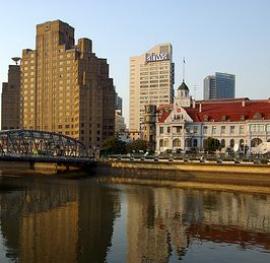Transforming An Urban Waterway
Shanghai, China
| Location | Shanghai, China |
|---|---|
| Pollutant | Residential and Industrial Waste. |
| Cause | Dumping of raw sewage in waterway, compounded by flooding. |
| Population Affected | 13.4 million [1]. |
| Health Impact | Untreated sewage spreads cholera, typhoid, and dysentery among urban populations and disproportionately affect children’s health. |
| Output | The Shanghai Government and Asian Development Bank teamed up to design and implement a 12-year project which included sewage treatment, injection of oxygen into the waterway, and flood controls to bring water quality to acceptable levels for household use. |
| Outcome | The first phase of the project improved water quality from worst than the lowest class in the national standard to Class III. The second phase aims at maintaining water quality while incorporating sustainable urban design elements in the rehabilitation system. |
| Intervention | This rehabilitation project demonstrated success in restoring contaminated water bodies in an urban setting as well as generating additional benefits such as increased green space and higher property values in the area. |
| Remaining Challenges | Despite ongoing billion-dollar investments and relocation/shutdown of industrial facilities, upstream pollution loads continue to threaten the Yangtze River. |
Context
More recently known as the most polluted water body in Shanghai or the “black and stink”, Suzhou Creek has been a historically important shipping and trading route in China since 1600s. Starting from 1920s, the Creek has observed severe pollution due to urban population growth, industrialization, raw sewage and other wastewater discharge, which directly damaged plant and aquatic species and caused algal bloom. As a source of irrigation and industrial water supply to Shanghai, poor water quality of the Creek also threatened health conditions of the 3 million residents in the area.
Site Details
Suzhou Creek is a 125-km waterway of which 54 km cuts through the city of Shanghai. The average depth is 2 to 4 meters at low tide and about 7 to 8 meters at high tide. Its upper reach receives water from Taihu, a large freshwater lake west of Shanghai that serves as a flood relief; the lower reach flows through downtown Shanghai and intersects with the Huangpu River before joining the Yangtze River. Suzhou Creek has an average net flow of 6 m3/s and 10 m3/s at the river mouth, of which 40 to 60 percent is contributed by the inflow of domestic and industrial wastewater along the banks. Pollution from human and industrial waste dumping over the past few decades led to visual pollution and release of a foul odor. Algal blooms became a common occurrence in the early summer. According to official sources in China, Suzhou Creek overall failed to meet Class V, the lowest of the national water quality standard. Out of the six branches of the Creek, Zhengru Port (Zhengrugang) was once recorded having water quality three to four times lower than Class V.
Health Impact
Sewage can carry potent human pathogens such as cholera, typhoid, and dysentery. Other diseases caused by sewage contamination of water include schistosomiasis, hepatitis A, and intestinal nematode infections, many of which can live in aquatic environments for extended periods of time.
The World Health Organization estimates that 1.5 million preventable deaths per year result from unsafe water, inadequate sanitation or hygiene, with young children being the largest group of victims. Another 860,000 children under age 5 are estimated to die annually as a direct or indirect result of the underweight or malnutrition associated with repeated diarrheal or intestinal nematode infections.
Exposure Pathways
Underdevelopment of sewage treatment systems and unregulated dumping of refuse continued to contaminate Suzhou Creek. Industrial, commercial, and residential waste was once visible on the surface of the Creek. Pollution enters human bodies and damages health in the following ways:
- Preparing food with/Drinking contaminated water: Untreated sewage can enter into drinking water pipes during rainfall events, directly reaching household water supplies.
- Absorbing pollutants through skin, eyes or ears: Humans are exposed to the pathogens in contaminated water from being in dermal contact, bathing, and washing.
Intervention
Suzhou Creek Rehabilitation Project
The Shanghai Municipal Government established the Suzhou Creek Rehabilitation Leader Group in the mid-1990s following the Central Government’s intent of pollution remediation. Granted a USD 300 million loan by the Asian Development Bank (ADB) in 1999 to implement the first phase of the plan, the Leader Group has been orchestrating an intervention for the site with a timeline of 12 years. Suzhou Creek Rehabilitation Project has three main objectives: to improve water quality, strengthen water resources management, and improve flood control. The first phase of the plan, launched in 1998 and successfully completed in 2003, prioritized the reduction of sewage discharge into the river, the installation of a water lock between the Huangpu River and Suzhou Creek, and the introduction of oxygen into the eutrophic water.
The Suzhou Creek Rehabilitation Leader Group works in concert with local construction companies to create a comprehensive water treatment solution for the area with environmental, health, and economic benefits. The Shanghai Fuxin Riverbed Treatment Co. Ltd focuses on the Zhengru Port, the most pollution area of the Creek, by diverting water flow into a treatment canal. The company applies a rigorous water treatment method by adding anaerobic bacteria into the black water to introduce oxygen. The bacteria-containing water then enters a silt pool 1m wide, 1.65 m deep and 60 m long, divided into six squares. By the time the black water entered the third square of the pool, the foul smell disappears and visibility increases. By the sixth pool, the water is clear to the bottom and healthy for fish to grow and has reached Class III of the national water standard, suggesting that it is clean enough for irrigation and as raw water for tap use.
The ongoing second phase commenced in 2003. Fully funded by the Shanghai Municipal Government, this phase aims to maintain and improve water quality of the Creek, to remedy water issues of the six tributaries, and to develop green spaces around Suzhou Creek. The Shanghai Suzhou Creek Rehabilitation Construction Company introduced the innovative design of Meng Qing Garden to serve as a landscaped recreational green space and functional wastewater treatment system which contains an equalization basin to store excessive rainwater in an underground storage tank and a base for environmental and water resources protection education. The second phase has a goal of restoring aquatic life by 2010. It is important to note that Suzhou Creek, which meets Taihu Lake, is an integral breeding ground for the Chinese Mitten Crab (also known as the big sluice crab), a seasonal delicacy in China that generates significant exports profit for the region.
Currently, the Rehabilitation Project has realized social, environmental, and economic benefits. Overall, the Suzhou Creek Rehabilitation Project relocated an estimate of 7,700 people but created job opportunities for 4,000 skilled and unskilled workers. It takes a comprehensive approach to tackle severe pollution issues of Suzhou Creek—a water body located in an urban setting and heavily connected with other major rivers in the region. Phase I of the Project treated immediate problems of Suzhou Creek by alleviating its odor and pathogens. Phase II further treats the contaminated water and integrates recreational elements into the design. Furthermore, the Shanghai Municipal Government proposed to construct biking/jogging trails, playgrounds, and parks along the Creek, in order to increase the environmental-friendly appeal of the city before the World Expo Shanghai in 2010. According to the ADB, property prices near Suzhou Creek have experienced double-digit since the implementation of the Rehabilitation Project. Excluding these figures, net economic benefits were estimated to be in excess of 4.1 billion RMB ($490 million) with a 22 percent rate of return.
Implementing Organizations
Asian Development Bank, Suzhou Creek Rehabilitation
Leader Group, Shanghai Suzhou Creek Rehabilitation
Construction Company, Shanghai Fuxin Riverbed Treatment Co. Ltd, CDM (construction contractors).
Remaining Challenges
Phase I of the Suzhou Creek Rehabilitation Project demonstrated success by dramatically improving the water quality standard from a few times worse than the lowest class to a level acceptable for everyday use. Phase II of the Project focuses on a broader regional scope including the Taihu Lake as well as the Yangtze River. Despite ongoing billion-dollar investments and relocation/shutdown of industrial facilities, upstream pollution loads continue to threaten the Yangtze River. Moreover, the Shanghai Municipal Government attempts to combine water treatment system components with its sustainable development plan due to limited and highly valuable urban space. In light of the Shanghai World Expo 2010, there are several proposals to expand green space along Suzhou Creek and increase pedestrian-friendliness in the downtown area. Phase II of the Project also aims at reviving water species that were wiped out by ongoing contamination and the devastating algal bloom in 2007.
References
Asian Development Bank (ADB) Project Completion Report: Suzhou Creek Rehabilitation Project (Loan 1692-PRC) In the People’s Republic of China. Sep 2005.
→ http://www.adb.org/Documents/PCRs/PRC/pcr-prc-32121.pdf
FAO Fisheries & Aquaculture China, Profiles home, 2009.
→ http://www.fao.org/fishery/countrysector/FI-CP_CN/en
The Consulate General of Switzerland in Shanghai-Commercial Section. Report on Shanghai Water Projects. Issue No. 4. Jul 2003.
→ http://www.sinoptic.ch/shanghaiflash/2003/200304.htm
Vollmer, D (2009). Urban waterfront rehabilitation: can it contribute to environmental improvement in the developing world?
→ http://stacks.iop.org/ERL/4/024003
World’s Worst Polluted Places Report 2008. Blacksmith Institute.
→ http://www.worstpolluted.org/projects_reports/display/63
Footnotes
[1] Asian Development Bank (ADB) Project Completion Report: Suzhou Creek Rehabilitation Project (Loan 1692-PRC) In the People’s Republic of China. Sep 2005.
→ http://www.adb.org/Documents/PCRs/PRC/pcr-prc-32121.pdf

-
Phasing Out Leaded Gasoline
-
Ending Chemical Weapons
-
Improving Indoor Air - Ghana
-
Preventing Mining Pollution - Chile
-
Lowering Radioactivity - Chernobyl
-
Cleaning Urban Air - India
-
Removing Lead - Dom. Republic
-
Recapturing Mercury - Indonesia
-
Reducing Lead - Russia
-
Removing DDT - Tanzania
-
Restoring a Waterway - China
-
Removing Arsenic - India



